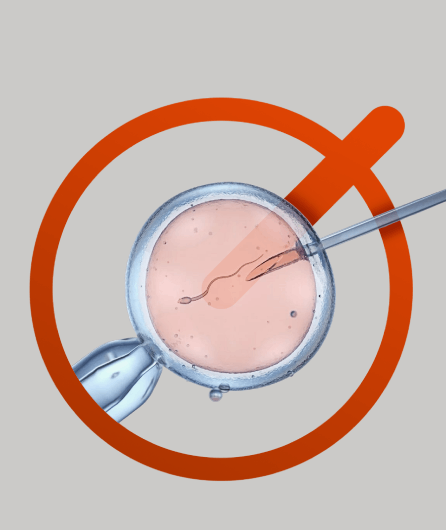THE FAMILY YOU’VE ALWAYS DREAMED OF
IN VITRO FERTILIZATION
In Vitro Fertilisation (IVF) is the most common and effective treatment in reproductive medicine. It is a technique that allows the fertilisation of the eggs by the sperm outside the woman’s body, in a controlled laboratory environment.
The embryo or 5-day embryos (known as 5-week embryos in their early development) are later transferred to the uterus to promote implantation and pregnancy.
At FIVClínic, we design a tailor-made treatment plan for each patient, drawing on the expertise of the Hospital Clínic de Barcelona, a highly specialised team, and state-of-the-art technology. Our goal: to guide you step by step through the in vitro fertilisation process and provide you with the best possible results, with the utmost human care.

INFERTILITY STUDY AND DIAGNOSIS
Every patient is unique, and so is every treatment at fivclínic+. Our goal is to identify the cause of infertility in the couple and create the most suitable IVF treatment plan. Schedule a consultation today, with no obligation.

ADVANTAGES OF IVF
IVF has higher pregnancy rates than natural conception and is the most common treatment in reproductive medicine. It allows the fertilisation of eggs by sperm outside the woman’s body. The embryos are then transferred to promote implantation. In vitro fertilisation offers multiple benefits compared to other fertility treatments. Among the advantages of IVF are the following:

HIGHLY VERSATILE PROCEDURE
The in vitro fertilisation process is tailored to each patient.
The eggs may be the patient’s own or from a donor, and the sperm may come from the partner or a sperm bank. This flexibility allows us to personalise the treatment and optimise the results according to age and ovarian reserve.

SINGLE MOTHERHOOD
Thanks to advances in in vitro fertilisation, many women can now become mothers without a partner, with the highest level of safety and medical assurance.
At FIVClínic, we provide personalised care for every case, offering medical, emotional, and psychological support throughout the entire treatment process.

ROBA METHOD
IVF allows two women to share motherhood. One provides the egg (genetic mother) and the other carries the pregnancy (gestational mother).
This in vitro fertilisation treatment is one of the most popular options among female couples, as it enables them to experience the process together and build a family in a shared and natural way.

PREIMPLANTATION GENETIC DIAGNOSIS (PGD)
In vitro fertilisation with preimplantation genetic diagnosis (PGD) allows embryos to be analysed before they are transferred to the uterus, reducing the risk of hereditary diseases.
PGD improves embryo selection and increases the chances of a healthy and successful pregnancy.

HIGH SUCCESS RATES
IVF pregnancy rates per transfer reach 50% in women under 35 years of age and exceed 80% with donated eggs. These results reflect a combination of medical excellence, advanced technology, and personalised support. Every year, more than 300 patients place their trust in FIVClínic to make their dream of becoming mothers come true.

CRYOPRESERVATION
In some cases, it is advisable to postpone the embryo transfer to a later cycle in order to improve implantation.
Embryo vitrification preserves their quality with a survival rate close to 90% and offers clear advantages: higher success in future IVF cycles, new pregnancies without repeated stimulation, and safety in the event of medical contingencies.

WHEN IS IVF RECOMMENDED?
In Vitro Fertilisation (IVF) is recommended in various cases of infertility or when other assisted reproduction treatments have not been effective.
Thanks to its versatility and high success rates, this in vitro fertilisation process makes it possible to offer personalised solutions according to each patient’s diagnosis and reproductive stage.
It is particularly indicated in the following cases:
-
In women with absence or damage to the fallopian tubes.
-
At advanced maternal age, when ovarian reserve is low or egg quality is reduced.
-
In cases of advanced endometriosis.
-
When there is a severe male factor (low sperm quality or abnormalities in the semen).
-
In cases of unexplained infertility of long duration.
At FIVClínic, we analyse each case individually to define the most suitable in vitro fertilisation schedule, optimising treatment time and the chances of pregnancy from the very first IVF cycle.
INFERTILITY STUDY AND DIAGNOSIS
At fivclínic+, we conduct personalized infertility evaluations, including the study of recurrent miscarriages, to tailor treatments and optimize outcomes. From your first visit, our goal is clear: to achieve pregnancy.

IN VITRO FERTILIZATION STEP BY STEP: THE COMPLETE PROCESS
The step-by-step in vitro fertilisation process consists of several stages that are carried out in a coordinated and controlled manner.
Although the duration of the treatment may vary for each patient, the IVF process timeline usually extends between three and five weeks, from ovarian stimulation to IVF embryo transfer.
1. CONTROLLED OVARIAN STIMULATION
To maximise the chances of pregnancy, it is necessary to increase the number of oocytes (eggs) and obtain a sufficient number of embryos to select those of the highest quality for transfer. Ovarian stimulation is a hormonal treatment that allows several follicles to grow simultaneously and the oocytes inside them to mature. Progress is monitored through successive ultrasound scans and hormonal tests. There are different ovarian stimulation protocols, and it is essential to define the most suitable one for each woman, depending on factors such as age, ovarian reserve, and medical history.
2. EGG RETRIEVAL (OVARIAN PUNCTURE)
Once the oocytes are mature, they are retrieved vaginally under ultrasound guidance. The procedure is painless, performed under local anesthesia and mild sedation. It takes about 15 minutes and does not require hospitalization, stitches, or general anesthesia.
The retrieved oocytes are kept in an incubator under optimal conditions until they are ready for fertilization.
3. SPERM PREPARATION
On the same day as the egg retrieval, a semen sample is required from the male partner. Alternatively, a previously cryopreserved sample or a sample from a sperm bank can be used.
Regardless of the source, the semen is processed in the laboratory to optimize the sperm’s fertilizing potential.
4. FERTILISATION IN THE LABORATORY
In the human embryology laboratory, fertilisation is facilitated by combining the oocyte with the partner’s sperm. This can be performed in a standard IVF cycle or by using the ICSI technique or intracytoplasmic sperm injection (ICSI), which involves selecting a viable sperm cell and inserting it directly into the oocyte using a fine needle — a procedure that facilitates fertilisation in cases of male infertility. ICSI is performed in most treatments to optimise outcomes. In both cases, around 70% to 80% of mature oocytes are successfully fertilised.
5. EMBRYO CULTURE
Following fertilization, the developing embryos are cultured in incubators with a specialized medium that provides the necessary nutrients for their growth. After 17-20 hours, the embryos are evaluated, and any abnormal fertilizations are excluded.
Patients are updated on the fertilization results, and if appropriate, the embryo transfer is scheduled. This transfer typically occurs between two and five days after the oocyte retrieval.
6. EMBRYO TRANSFER
Embryo transfer is a critical step in the IVF process. It involves placing one or more selected embryos into the mother’s uterus under ultrasound guidance. The culture medium containing the embryo is gently deposited inside the uterus. This is a short, painless procedure.
The number of embryos transferred depends on various factors, including the woman’s age, the cause and duration of infertility, previous pregnancies, and particularly the number and quality of the embryos. The maximum legal limit for embryo transfer is three.
7. PREGNANCY CONFIRMATION TEST
Thirteen to fourteen days after starting progesterone, we schedule a blood test to confirm pregnancy. This test measures the level of beta-hCG, a hormone produced by the embryo that is passed on to the mother.
8. FOLLOW-UP ULTRASOUND
If the pregnancy test is positive, an ultrasound is performed about two weeks later. Performing it earlier could lead to confusion or uncertainty, as early ultrasounds often yield inconclusive results.

WHEN IS EMBRYO CRYOPRESERVATION NECESSARY?
Traditionally, embryos resulting from IVF were transferred during the same stimulation cycle. However, recent scientific evidence suggests that, in certain cases, delaying the transfer to a later cycle may enhance implantation success. In such cases, embryo freezing or cryopreservation is recommended.
ADVANTAGES OF CRYOPRESERVATION
• Increased Success Rates: If pregnancy is not achieved after a fresh transfer, cryopreserved embryos offer additional opportunities for success in subsequent cycles.
• Future Pregnancies: Cryopreservation facilitates additional pregnancies without the need for repeat hormonal stimulation if the initial IVF cycle was successful and the patient seeks to expand their family.
• Flexibility: If unforeseen contraindications arise, cryopreservation allows for the preservation of embryos until the patient is ready for transfer.
THE CRYOPRESERVATION PROCESS
Embryo cryopreservation, or vitrification, is the most commonly used freezing technique in assisted reproduction. This method involves rapid freezing to prevent ice crystals from forming, which could damage the cells. Vitrification boasts high survival and viability rates for cells. However, not all embryos are suitable for cryopreservation; only those of sufficient quality are frozen.
This technique has significantly improved outcomes for embryo transfer during thawing cycles in recent years.
HOW IS THE TRANSFER OF CRYOPRESERVED EMBRYOS PERFORMED?
In the case of transferring previously frozen embryos, the first step is to thaw and evaluate them. Although there is some variability, it is estimated that around 90% of thawed embryos will be in good condition for transfer. Once rehydrated, they are placed in a culture medium until the time of transfer, which can be performed in two ways:
TRANSFER OF FROZEN EMBRYOS IN A NATURAL CYCLE
The transfer can be done during a natural cycle, timed to coincide with ovulation. The main advantage of this procedure is that it can be performed without medication, simply monitoring the woman’s natural cycle and timing the embryo transfer for the optimal moment.
TRANSFER OF FROZEN EMBRYOS IN A SUPPORTED CYCLE
The supported or “artificial” cycle involves performing the cryotransfer after optimizing endometrial receptivity (the inner lining of the uterus) through the administration of estrogen and progesterone. This approach is recommended for anovulatory patients, those with irregular cycles, or those without ovarian function. It may also be beneficial for certain normoovulatory patients.
WHY CHOOSE FIVCLÍNIC+?

Results that validate our experience
Our success rates are around 50% with own eggs and 80% with donor eggs. To achieve these results, we believe it is essential to carry out a comprehensive infertility assessment and diagnosis to personalise the treatment.

+300 IVF treatments per year
We carry out more than 300 In Vitro Fertilisation treatments every year, all supported by the infrastructure and technology of barnaclínic+ and the Hospital Clínic de Barcelona. Our recently renovated assisted reproduction laboratory is equipped with real-time embryo culture systems and cutting-edge technology to ensure maximum safety and precision at every stage of the process.

+20 years of experience in assisted reproduction
We have a multidisciplinary team made up of specialists in gynaecology, embryology, genetics, andrology, and psychology. Over two decades dedicated to fertility have made us a benchmark in reproductive medicine, combining scientific excellence with the human sensitivity that every case requires.

Comprehensive care and human support
Every patient is unique, and that is how we approach each treatment. At FIVClínic, we accompany you before, during, and after the IVF process, offering clear information, emotional support, and continuous follow-up. Our comprehensive care model includes medical guidance, psychological counselling, and direct, ongoing communication with your medical team.

Innovation, ethics and transparency
As part of the Hospital Clínic de Barcelona, we are pioneers in biomedical research and technological development applied to fertility. We incorporate the latest scientific advances with the utmost ethics, transparency, and humanity, ensuring that every patient feels heard, informed, and fully supported on her journey to motherhood.
CALL US OR, IF YOU PREFER, LEAVE US YOUR CONTACT NUMBER AND WE WILL CALL YOU
+34 93 227 57 44







